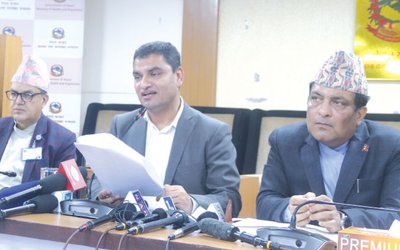
Chief Secretary Shanker Das Bairagi was admitted to the hospital on Monday after he was infected by Degue. He is first high ranking officials to admit the hospital. His condition reportedly normal.
Although the Kathmandu Valley has become the hotspot for dengue outbreak, central, federal and local governments have not done enough to contain it. According to the EDCD data, Kathmandu has recorded 8,896 cases of dengue and Lalitpur 6,035.
Nepal has recorded more than 25,000 dengue cases as of Monday. According to the Epidemiology and Disease Control Division (EDCD) under the Ministry of Health and Population (MoHP), 32 people have died of dengue as of Monday.
As per the data provided by the EDCD, 25,543 cases of dengue have been reported from across the nation.
According to the EDCD, Bagmati Province has reported the highest number of dengue cases at 19,910 followed by Lumbini Province with 2,887 cases. Likewise, in Province 1, 775 cases were detected, 804 in Sudhurpaschim Province, 556 in Gandaki Province, 380 in Madhes Province and 231 in Karnali Province.
Dengue cases have been recorded in 76 of 77 districts throughout the nation. Of them, 10 districts are affected more by dengue. They are Kathmandu, Lalitpur, Makwanpur (2,375 cases), Dang (1,278), Bhakatapur (1,058), Rupandehi (726), Chitwan (601), Dhading (449) Gulmi (298) and Kailali (298).
Dengue is also called ‘break-bone fever’ and the patients show the symptoms three to seven days after the bites of mosquitoes-- Aedes aegypti and Aedes albopictus.
“A preliminary report of the study carried out by the EDCD in the Kathmandu Valley shows that high density of dengue-spreading mosquitoes has been found in the valley,” according to Dr. Gokarna Dahal, chief of Vector Control Section at the EDCD.
The virus-infecting vector has been found in the dense areas where search and destroy drive has been carried out, said Dr. Dahal.
There is a high risk of outbreak of infection where the high density of the vector prevails, warned Dr. Dahal.
The EDCD is also planning to conduct a vector study in the dengue affected districts.
According to Dr. Dahal, both Aedes aegypti and Aedes albopictus mosquitoes have been found in the Kathmandu Valley in abundance.
Experts have been warning that the ongoing spread of the virus could continue until November. The health experts suggested conducting ‘search and destroy’ drive regularly to reduce the mosquito breeding sites to contain the spread of dengue infection.
With information from The Rising Nepal
- Minister Dahal Directed To Complete The Dannune Portion Of Road Before Monsoon
- Apr 18, 2025
- Kanchenjunga Diamond Festival Being Celebrated From Today To Mark The 70th Anniversary Of The First Successful Ascent
- Apr 18, 2025
- RPP To Hold Protest In Restricted Areas Of Kathmandu On April 20
- Apr 18, 2025
- Weather Forecast: Partly Cloudy With Rain And Thunder In Kathmandu, Pokhara, Biratnagar And Janakpur
- Apr 18, 2025
- Himalaya Airlines continues its CSR bonding with Prayas Nepal children
- Apr 17, 2025















